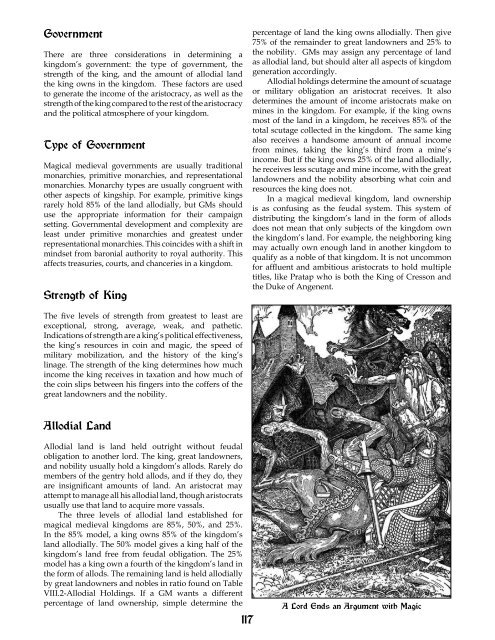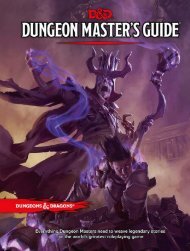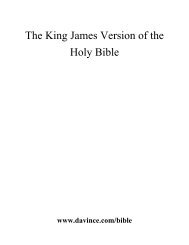You also want an ePaper? Increase the reach of your titles
YUMPU automatically turns print PDFs into web optimized ePapers that Google loves.
Government<br />
There are three considerations in determining a<br />
kingdom’s government: the type of government, the<br />
strength of the king, and the amount of allodial land<br />
the king owns in the kingdom. These factors are used<br />
to generate the income of the aristocracy, as well as the<br />
strength of the king compared to the rest of the aristocracy<br />
and the political atmosphere of your kingdom.<br />
Type of Government<br />
<strong>Magical</strong> medieval governments are usually traditional<br />
monarchies, primitive monarchies, and representational<br />
monarchies. Monarchy types are usually congruent with<br />
other aspects of kingship. For example, primitive kings<br />
rarely hold 85% of the land allodially, but GMs should<br />
use the appropriate information for their campaign<br />
setting. Governmental development and complexity are<br />
least under primitive monarchies and greatest under<br />
representational monarchies. This coincides with a shift in<br />
mindset from baronial authority to royal authority. This<br />
affects treasuries, courts, and chanceries in a kingdom.<br />
Strength of King<br />
percentage of land the king owns allodially. Then give<br />
75% of the remainder to great landowners and 25% to<br />
the nobility. GMs may assign any percentage of land<br />
as allodial land, but should alter all aspects of kingdom<br />
generation accordingly.<br />
Allodial holdings determine the amount of scuatage<br />
or military obligation an aristocrat receives. It also<br />
determines the amount of income aristocrats make on<br />
mines in the kingdom. For example, if the king owns<br />
most of the land in a kingdom, he receives 85% of the<br />
total scutage collected in the kingdom. The same king<br />
also receives a handsome amount of annual income<br />
from mines, taking the king’s third from a mine’s<br />
income. But if the king owns 25% of the land allodially,<br />
he receives less scutage and mine income, with the great<br />
landowners and the nobility absorbing what coin and<br />
resources the king does not.<br />
In a magical medieval kingdom, land ownership<br />
is as confusing as the feudal system. This system of<br />
distributing the kingdom’s land in the form of allods<br />
does not mean that only subjects of the kingdom own<br />
the kingdom’s land. For example, the neighboring king<br />
may actually own enough land in another kingdom to<br />
qualify as a noble of that kingdom. It is not uncommon<br />
for affluent and ambitious aristocrats to hold multiple<br />
titles, like Pratap who is both the King of Cresson and<br />
the Duke of Angenent.<br />
The five levels of strength from greatest to least are<br />
exceptional, strong, average, weak, and pathetic.<br />
Indications of strength are a king’s political effectiveness,<br />
the king’s resources in coin and magic, the speed of<br />
military mobilization, and the history of the king’s<br />
linage. The strength of the king determines how much<br />
income the king receives in taxation and how much of<br />
the coin slips between his fingers into the coffers of the<br />
great landowners and the nobility.<br />
Allodial Land<br />
Allodial land is land held outright without feudal<br />
obligation to another lord. The king, great landowners,<br />
and nobility usually hold a kingdom’s allods. Rarely do<br />
members of the gentry hold allods, and if they do, they<br />
are insignificant amounts of land. An aristocrat may<br />
attempt to manage all his allodial land, though aristocrats<br />
usually use that land to acquire more vassals.<br />
The three levels of allodial land established for<br />
magical medieval kingdoms are 85%, 50%, and 25%.<br />
In the 85% model, a king owns 85% of the kingdom’s<br />
land allodially. The 50% model gives a king half of the<br />
kingdom’s land free from feudal obligation. The 25%<br />
model has a king own a fourth of the kingdom’s land in<br />
the form of allods. The remaining land is held allodially<br />
by great landowners and nobles in ratio found on Table<br />
VIII.2-Allodial Holdings. If a GM wants a different<br />
percentage of land ownership, simple determine the<br />
117<br />
A Lord Ends an Argument with Magic




